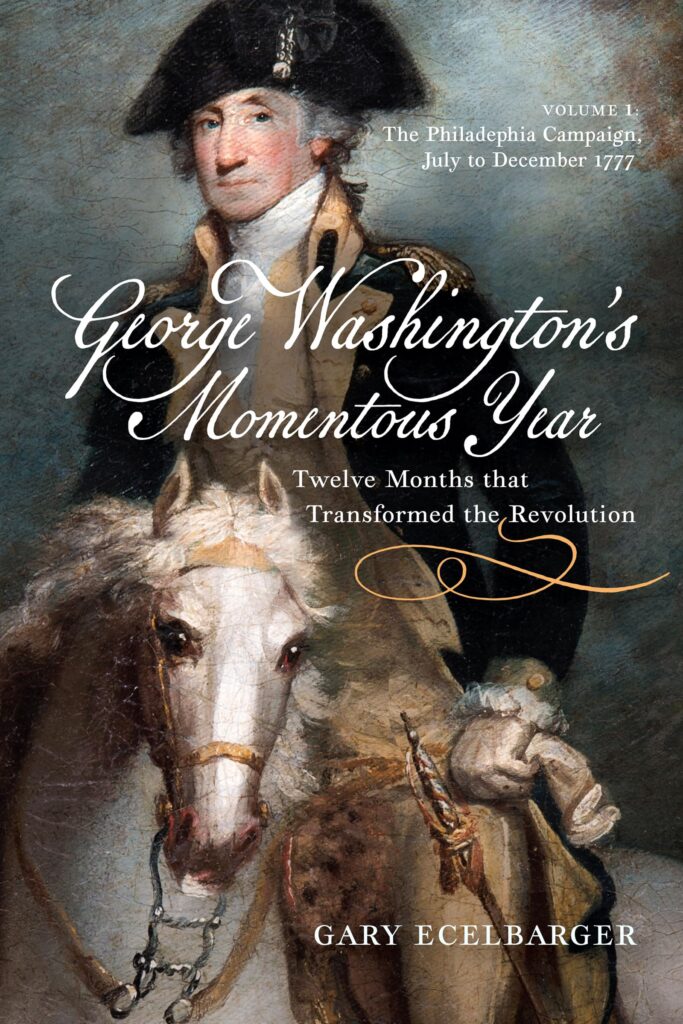By Gary Ecelbarger.
Yardley, PA: Westholme Publishing, 2024.
ISBN 978-1-59416-422-4. Illustrations. Notes. Bibliography. Index.
Pp. xiii, 286. $34.95.
Although a number of excellent battle studies of the Philadelphia Campaign have previously been published, Gary Ecelbarger tailored his research toward unexplored aspects of the perilous 1777 campaign season. Far from a traditional military history, George Washington’s Momentous Year is a detailed and fascinating look at the oft-neglected but crucial disciplines of command, control, and logistics.
By the summer of 1777, the American Revolution was entering its third year, and American fortunes were at low ebb. General George Washington maintained a tenuous position in northern New Jersey. Forced to adopt a rather static defensive posture, Washington was compelled to largely sit tight and await the enemy’s next move. For an inherently aggressive field commander like Washington, it was a decidedly unpleasant scenario that ran counter to his own inclinations.
That wait-and-see approach was necessitated by Britain’s unquestioned naval superiority. At the end of July, General Sir William Howe set sail from New York with an imposing 13,000-man army. Unfortunately for the Americans, Howe’s ultimate target was a mystery. Two options remained the most obvious British objectives: a drive up the Hudson River for a linkup with General John Burgoyne’s army in northern New York, or an attempt against the American capital at Philadelphia.
Contradictory intelligence left Washington gripped with indecision for over a month. Forced to spread out his forces to cover either eventuality, elements of the Main Army were spread dangerously thin. When Howe and his fleet finally appeared in the Chesapeake Bay on 25 August, Washington acted decisively, immediately moving into a position to protect Philadelphia.
Over the succeeding two months, Washington waged an epic campaign in defense of the American capital. Washington would fight two major battles: narrowly avoiding disaster at Brandywine and then launching an audacious attack of his own at Germantown. Ecelbarger tells the tale of the Philadelphia Campaign from a unique standpoint. Rather than focus his attention on Washington the warfighter, he chronicles the development of Washington as a military manager.
To do so, Ecelbarger introduces readers to the behind-the-scenes world of Washington’s personal staff, a close-knit group of young officers commonly known as his “military family.” The simple mechanics of wielding a field army is a massive undertaking requiring resourceful subordinates. Ecelberger explores Washington’s development as a leader who was constantly on the lookout for talented junior officers, who slowly assembled a streamlined staff that he could rely on.
That staff was crucial to the Army as it waged an intense war of maneuver during 1777. Washington, who had commanded troops at the regimental level during the French and Indian War, was coming into his own as the commander of a modern army. It was a difficult crash course in a high-stakes game. Ecelbarger does an excellent job of untangling the complicated geography and logistical constraints that shaped the campaign.
As the Continental Army slowly transformed from an inexperienced militia force to a seasoned professional army, Washington began making the transition from a defensive war of attrition to a mobile conflict that saw him repeatedly attempt to seize the strategic initiative. Washington would come to see the necessity of beating the British in open battle but was repeatedly frustrated in his attempts to do so.
Ecelbarger is a veteran researcher and author who has written extensively on American military history. His latest volume, engagingly written but thoroughly researched, is appropriate for a full spectrum of history enthusiasts, from informed readers with a casual interest in the war to academics specializing in the Revolution. Simply due to the subject matter of the book, it can be a slow read compared with a conventional military history, but it is an enlightening book nonetheless.
With the release of George Washington’s Momentous Year, Ecelbarger plows remarkably fresh ground in the historiography of the American Revolution. Considering the breadth and depth of scholarship that the Revolutionary War has received in over two centuries, Ecelberger’s projected two-volume study is a commendable accomplishment.
Joshua Shepherd
Union City, Indiana
